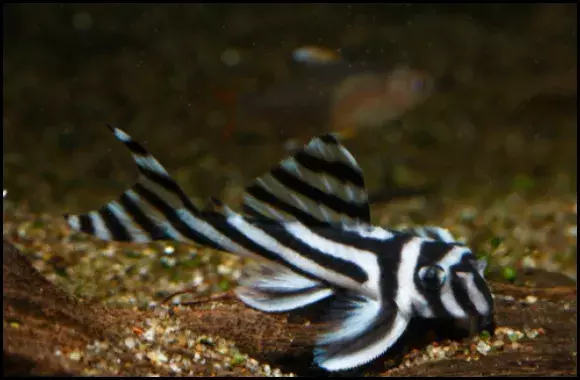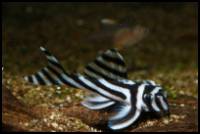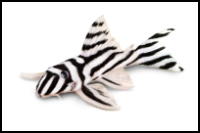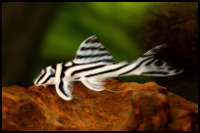



Quick Care Details (Table)
| Livestock Characteristics | Value |
|---|---|
| Care Level | Moderate |
| Temperament | Peaceful |
| Diet | Omnivore |
| Maximum Size | 4 Inches |
| Minimum Tank Size | 20 Gallons |
| Plant Safe | Yes |
| Temperature Range | 78-82°F |
| PH Range | 6.0-7.5 pH |
| KH Range | 2-10 dKH |
| GH Range | 2-10 dGH |
Species Specific Categories
Helpful Video
Care Details
Aquascape
- Provide a natural-looking setup with rocks, caves, and driftwood to mimic the Zebra Pleco's native habitat.
- Create hiding spots to make the pleco feel secure and less stressed.
- Use live plants or artificial ones that won't harm the pleco's delicate fins.
Substrate
- Opt for a fine-grained substrate to avoid injuring the pleco's sensitive barbels.
- Dark-colored substrates can enhance the Zebra Pleco's striking coloration and reduce stress.
Disease Prevention
- Quarantine new fish before introducing them to the main tank to prevent the spread of potential diseases.
- Maintain excellent water quality with regular water changes and filtration to reduce stress and susceptibility to diseases.
- Avoid overstocking the tank, as crowded conditions can lead to stress and disease outbreaks.
Filtration
- Use a high-quality filtration system capable of handling the bioload of the tank, as plecos produce a significant amount of waste.
- Consider using a canister or sponge filter, as these are gentler on the Zebra Pleco's fins.
- Ensure the filtration system doesn't create strong currents that might stress the pleco.
Lighting
- Zebra Plecos prefer subdued lighting conditions in their aquarium, replicating the dimly lit environment of their natural habitat.
- Use low-intensity or full-spectrum LED lights with adjustable brightness settings to mimic natural day-night cycles.
Water Flow
- Avoid strong water flow, as Zebra Plecos come from slow-moving river systems.
- Use a gentle water flow provided by the filtration system or air-driven sponge filters to ensure comfort and reduce stress.
Hardiness
- Zebra Plecos are relatively hardy fish, but they require stable water conditions and a well-maintained environment.
- Keep water parameters consistent, including temperature, pH, and water hardness, to promote the pleco's well-being.
- Provide a well-balanced diet and offer varied foods to ensure nutritional needs are met.
Temperament and Behavior
Behavior and Social Interaction
- Zebra Plecos are generally peaceful and shy, spending much of their time hiding in caves or crevices during the day.
- They are more active during the nighttime, when they come out to forage for food.
Aggression
- Zebra Plecos are not known to be aggressive towards other fish or even members of their own species.
- However, they can become territorial, especially when breeding or if their hiding spots are threatened.
Breeding
- Breeding Zebra Plecos can be challenging due to their specific environmental requirements and picky nature when choosing nesting sites.
- Males may become territorial and engage in courtship behavior by cleaning potential nesting spots and attracting females.
Compatibility
- Zebra Plecos are generally compatible with other peaceful fish species that won't outcompete them for food or stress them out.
- Avoid keeping them with larger, more aggressive fish that could harm or intimidate them.
Activity Level
- Zebra Plecos are primarily nocturnal, which means they are most active during the night and prefer to hide during the day.
- Their nocturnal behavior can make them less visible during daylight hours.
Clean Up Crew
- Zebra Plecos are excellent algae eaters and can help keep the aquarium clean by consuming algae on rocks and surfaces.
- However, they might not eat all types of algae, so it's essential to provide a balanced diet to ensure they get enough nutrition.
Schooling or Shoaling Behavior
- Zebra Plecos are not schooling or shoaling fish; they are solitary by nature and prefer to stay alone or in male-female pairs during the breeding season.
- They don't exhibit the shoaling behavior seen in some other species of fish.
Diet and Nutrition
Dry Foods
- Zebra Plecos can be fed high-quality sinking pellets or granules specifically designed for bottom-dwelling fish.
- Look for pellets with a high vegetable content to cater to their herbivorous nature.
- Opt for small-sized pellets to ensure they can be easily consumed.
Frozen Foods
- Offer frozen foods like bloodworms, brine shrimp, and daphnia as occasional treats.
- Frozen foods provide essential protein and variety to their diet.
- Thaw the frozen foods before feeding to prevent digestive issues.
Live Foods
- Zebra Plecos will readily consume live foods like blackworms and brine shrimp.
- Live foods are highly nutritious and mimic their natural diet in the wild.
- Ensure the live foods are from reputable sources to avoid introducing parasites or diseases.
Vegetables
- Supplement their diet with blanched vegetables like zucchini, cucumber, or spinach.
- Vegetables provide essential vitamins and fiber to promote good health.
- Remove any uneaten vegetables after a few hours to maintain water quality.
Algae
- Algae is a significant part of the Zebra Pleco's diet in the wild, and they will consume algae present in the aquarium.
- While they are effective algae eaters, they might not eat all types of algae, so additional foods are necessary.
Feeding Schedule
- Offer small amounts of food two to three times a day.
- Space out the feedings to prevent overeating and avoid wasting food.
- Observe their eating habits and adjust the feeding schedule as needed.
Supplemental Foods
- Include supplements like spirulina-based foods or algae wafers to enhance their diet.
- These foods can provide essential nutrients and cater to their herbivorous preferences.
- Use supplements sparingly and alongside a varied diet for balanced nutrition.
Tank Parameters
Tank Size
- Zebra Plecos require a tank size of at least 20-30 gallons for a single adult.
- However, due to their territorial nature and the potential for breeding, a larger tank is preferable.
- For a breeding pair or a small group, a tank size of 50-75 gallons or more is recommended.
Tank Length and Measurements
- The tank should provide ample horizontal swimming space for the Zebra Plecos.
- Aim for a tank length of at least 36 inches (90 cm) or more to accommodate their active nocturnal behavior.
The Species Maximum Size
- The Zebra Pleco (Hypancistrus zebra) can grow up to about 3-4 inches (7.5-10 cm) in length.
- While they are relatively small, their active behavior and territorial tendencies require sufficient space.
Water Temperature
- Zebra Plecos prefer a water temperature between 78-82°F (25-28°C).
- Keeping the water within this range will mimic their natural tropical habitat and promote their well-being.
pH (Acidity/Alkalinity)
- Maintain the pH level of the water between 6.0 to 7.5.
- The Zebra Pleco prefers slightly acidic to neutral water conditions.
KH (Carbonate Hardness)
- Aim for a KH level of 2-10 dKH (degrees of carbonate hardness).
- Carbonate hardness helps stabilize the pH level and buffer against sudden fluctuations.
GH (General Hardness)
- Keep the GH level between 2 to 10 dGH (degrees of general hardness).
- Zebra Plecos can adapt to a range of water hardness, but softer water conditions are preferable.
Nitrate (NO3) Levels
- Regularly monitor nitrate levels and maintain them below 20-30 ppm (parts per million).
- Elevated nitrate levels can be harmful to Zebra Plecos, so perform regular water changes to keep nitrates in check.
History, Popularity, History and Species Variety Details
The History, Popularity and Habitat
History: The zebra pleco, Hypancistrus zebra, was first discovered and scientifically described in the 1980s. The species was initially found in the Xingu River, a tributary of the Amazon River, in Brazil. The Xingu River basin is known for its rich biodiversity, and the zebra pleco is just one of the many unique species that call this region home.
The zebra pleco's striking appearance and limited distribution in the wild quickly captured the attention of aquarium enthusiasts and collectors worldwide. Due to its rarity and beauty, the demand for zebra plecos in the aquarium trade surged, leading to concerns about overcollection and its potential impact on the species' population in the wild.
Popularity: The zebra pleco quickly gained popularity in the aquarium hobby due to its distinctive black and white striped pattern, which resembles that of a zebra. Its small size, peaceful nature, and compatibility with other non-aggressive fish further contributed to its appeal among hobbyists.
However, the zebra pleco's popularity also brought about significant challenges. The high demand for this species in the aquarium trade led to increased collection from the wild, which, coupled with habitat destruction, posed a threat to its natural population. As a result, regulatory measures were implemented to restrict or ban the export and trade of wild-caught zebra plecos to protect the species from exploitation.
Habitat: In the wild, zebra plecos are native to the rocky, fast-flowing waters of the Xingu River basin. This river system is located in the northern region of Brazil, within the Amazon Rainforest. The Xingu River is characterized by its clear, oxygen-rich waters and varying water currents.
The zebra pleco's natural habitat consists of rocky riverbeds with numerous caves, crevices, and submerged wood, providing them with plenty of hiding spots and shelter. They prefer dimly lit environments to mimic the natural conditions found in their riverine homes.
Because the Xingu River basin has a diverse ecosystem, the zebra pleco coexists with various other fish species, including tetras, cichlids, and other plecos. These interactions, along with the unique environmental conditions of the Xingu River, have influenced the zebra pleco's behavior, diet, and physical characteristics.
Conservation efforts: As mentioned earlier, the zebra pleco is listed as an endangered species by the International Union for Conservation of Nature (IUCN). Conservation efforts are essential to protect the zebra pleco from further habitat destruction and overcollection.
To safeguard the species, measures have been taken to limit or ban the export and trade of wild-caught zebra plecos. Additionally, captive breeding programs have been established in the aquarium community to reduce pressure on wild populations and make these captivating fish more accessible to enthusiasts without impacting their natural habitat.
These efforts not only aid in the preservation of the zebra pleco but also raise awareness about the importance of responsible aquarium fishkeeping and the need to protect endangered species and their habitats worldwide.
Back to topFish Types
- Wild-type Zebra Pleco: The wild-type zebra pleco is the original and natural form of Hypancistrus zebra found in the Xingu River. As described earlier, it features bold black and white stripes across its body, resembling a zebra pattern.
- Longfin Zebra Pleco: This variation has been selectively bred for longer and more elaborate fins compared to the standard wild-type zebra pleco. The flowing fins add elegance to their appearance and make them even more appealing to aquarium hobbyists.
- Super White Zebra Pleco: The super white zebra pleco is a selectively bred variant that exhibits more white coloration than the wild-type zebra pleco. The black stripes may be less pronounced or even absent in some individuals, giving them an overall whiter appearance.
- Albino Zebra Pleco: The albino zebra pleco is a color morph that lacks melanin pigmentation, resulting in an overall white or cream-colored body with pinkish or red eyes. Albino zebra plecos still display the characteristic zebra stripes, but in lighter colors.
- Gold Zebra Pleco: The gold zebra pleco is a variation that exhibits a golden or yellowish body coloration instead of the traditional black and white pattern. The intensity of the gold color can vary among individuals, with some displaying subtle hues and others being more vibrant.
Common Tankmates
- Small Tetras: Peaceful species like neon tetras, cardinal tetras, ember tetras, or glowlight tetras can make suitable tank mates. They add color and liveliness to the aquarium and generally stay in the middle and upper water levels, leaving the bottom areas for the zebra plecos.
- Corydoras Catfish: Many species of Corydoras catfish are peaceful and well-suited for a tank with zebra plecos. They are bottom-dwellers like the zebra plecos and have a similar diet, making them compatible companions.
- Otocinclus Catfish: Otocinclus catfish, often called otos, are small and peaceful algae-eating fish. They help keep the tank clean by consuming algae growth on plants and decor, making them beneficial companions for zebra plecos.
- Dwarf Cichlids: Some smaller and peaceful dwarf cichlid species, such as Apistogramma or German Blue Rams, can coexist with zebra plecos. Ensure that the cichlid species you choose are not overly territorial or aggressive.
- Small Rasboras: Peaceful rasboras, such as harlequin rasboras or chili rasboras, can be good tank mates. They are relatively small and have a calm demeanor, which works well with the zebra plecos' temperament.
- Peaceful Shrimp: Some small, non-aggressive shrimp species, such as cherry shrimp or amano shrimp, can be added to the tank. They help with algae control and add interest to the aquarium.
Male gender vs Female gender (Sexual Dimorphism)
- Observe Size Differences: In general, adult male zebra plecos tend to be slightly larger and more robust than females. Males might also have slightly broader heads and a more muscular appearance.
- Check for Papillary Processes (Bristles): One of the most common methods to identify the gender of adult zebra plecos is to look for bristle-like structures on the snout of males. These are called papillary processes and are more prominent in mature males. These bristles are believed to play a role in mating and territorial behavior. Females usually have smaller or no bristles.
- Observe the Belly and Genital Papillae: In some cases, you might be able to differentiate males and females by examining their bellies. Males typically have a more pronounced and pointed genital papillae, which is a small, cone-shaped structure located between the anal and pelvic fins. In females, the genital papillae is usually rounder and less pointed.
- Study Behavior During Breeding: Observing their behavior during breeding can provide clearer clues about their gender. Males are often more territorial and aggressive during breeding, while females might show nesting behaviors and protective instincts over their offspring.
- Wait for Reproductive Behavior: As they reach sexual maturity, males may display courting behavior, such as chasing and circling potential mates. Females might show interest in caves or potential nesting spots.
Breeding
- Set up the Breeding Tank: Create a separate breeding tank to mimic the natural habitat of zebra plecos. Use a tank with a capacity of at least 20-30 gallons (75-115 liters). The tank should have plenty of hiding spots, such as caves, PVC pipes, or coconut shells, where the zebra plecos can lay their eggs. Provide a soft substrate, like sand or fine gravel, and maintain good water quality with regular water changes.
- Choose Compatible Pairs: Select a mature male and female zebra pleco for breeding. If possible, try to observe their behavior in a community tank to identify potential pairs that get along well. A compatible pair is more likely to breed successfully.
- Condition the Breeding Pair: Before attempting to breed, condition the zebra plecos with a nutritious and varied diet. Offer them high-quality foods, including live or frozen foods like bloodworms, brine shrimp, and blackworms. A well-balanced diet will help them reach optimal breeding condition.
- Provide a Suitable Breeding Cave: Zebra plecos are cavity spawners, meaning they prefer to lay their eggs in hidden spaces like caves or crevices. Provide a suitable breeding cave in the breeding tank where the female can deposit her eggs, and the male can fertilize them. Natural caves or specially designed spawning caves can be used.
- Observe Breeding Behavior: Zebra plecos usually breed at night. During the breeding process, the male will often defend the breeding cave and may become more territorial. The female will lay her eggs inside the cave, and the male will then fertilize them. After spawning, the male will continue to guard the eggs.
- Separate the Male After Spawning: Once the female has laid her eggs and the male has fertilized them, consider removing the male from the breeding tank. Some male zebra plecos may become aggressive towards the female or the eggs, which could lead to a failed breeding attempt. Removing the male can help ensure the safety of the eggs.
- Incubate the Eggs: Allow the female to tend to the eggs and protect them. Zebra plecos are excellent parents and will usually take good care of their offspring. The eggs typically hatch within 5 to 10 days, depending on water conditions and temperature.
- Feed the Fry: Once the eggs have hatched, the fry (baby zebra plecos) will consume their yolk sac for the first few days. After that, you can start feeding them infusoria, baby brine shrimp, or other suitable fry foods.
- Provide Suitable Tank Conditions for Fry: Maintain excellent water quality in the fry tank, and ensure that they have plenty of hiding spots to stay safe from potential predators. Avoid sudden water changes, as it could stress the fry.
Frequently Asked Questions
What is a zebra pleco?
The zebra pleco (Hypancistrus zebra) is a small, freshwater fish known for its striking black-and-white striped pattern, resembling that of a zebra. It's native to the Xingu River in Brazil and is popular among aquarium enthusiasts.
How big do zebra plecos grow?
Zebra plecos typically grow to about 3 to 4 inches (7.5 to 10 cm) in length.
What should I feed my zebra pleco?
In the wild, zebra plecos are omnivorous, feeding on small insects, crustaceans, and plant matter. In captivity, they can be fed high-quality sinking pellets, frozen or live foods like bloodworms and brine shrimp, and some vegetable matter.
Can zebra plecos be kept with other fish?
Yes, zebra plecos can coexist with peaceful and non-aggressive fish like small tetras, corydoras catfish, otocinclus catfish, and dwarf cichlids. Avoid keeping them with larger or aggressive species.
Are zebra plecos difficult to breed?
Yes, breeding zebra plecos can be challenging. They are cavity spawners and require specific conditions and suitable caves for successful breeding.
How can I tell the gender of my zebra plecos?
Male zebra plecos may have bristle-like structures on their snout called papillary processes. Males may also be slightly larger and more robust than females.
Are zebra plecos endangered?
Yes, the zebra pleco is listed as an endangered species by the International Union for Conservation of Nature (IUCN) due to habitat destruction and overcollection for the aquarium trade.
Can zebra plecos live in a community tank?
Zebra plecos can live in a community tank with compatible and non-aggressive tank mates, as long as they have enough hiding spots and space for themselves.
How long do zebra plecos live?
With proper care, zebra plecos can live for about 10 to 15 years in captivity.
Are zebra plecos good algae eaters?
While zebra plecos may consume some algae, they are not as efficient at algae control as some other species like otocinclus catfish. They primarily prefer a varied diet of protein-rich foods.

